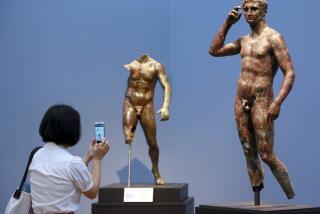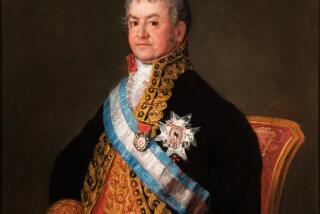Getty Museum buys ‘Rembrandt Laughing’: tiny portrait, huge value
- Share via
Stepping up the effort to strengthen its European art collection, the Getty Museum has acquired two major Old Masters paintings: an exuberant early self-portrait of Rembrandt from around 1628, and a classic scene of the Grand Canal in Venice by Canaletto from around 1738.
The purchases were made last week for undisclosed prices, but experts believe the Rembrandt alone — a rare-to-market self-portrait that stunned the art world when it turned up in a country auction in England in 2007 — would run into the tens of millions of dollars.
The exact price could be revealed when the Getty applies for an export license from the British government, which gives museums there a chance to match the price for an artwork of “outstanding significance” historically or artistically and keep it in the country.
ART: Can you guess the high price?
Getty Museum director Timothy Potts nonetheless spoke confidently about adding the painting to its collection and how it would complement the Getty’s holdings.
“We are building on existing strengths of our collection, adding luster to our collection,” said Potts, calling Rembrandt’s depiction of himself over the years his “most sustained and remarkable achievement.”
“We feel we know Rembrandt better than any other artist who lived because we see his face in portraits from when he was a young man in his 20s just starting out, virtually all the way through to his death,” Potts said. “So he’s in a sense his own greatest subject, and these are among the most admired works he ever made.”
Painted on copper plate, the work the Getty is buying is tiny — not quite 9 by 7 inches. It shows the artist in his early 20s in mid-laugh, with his head thrown back.
It first came to public attention at the English country auction, which identified it as work by “a follower of Rembrandt.” The auctioneers estimated its value at around $3,000.
But scholars suspected this joyful image was the real deal, so a bidding war erupted. The painting sold for about $5.2 million to an unidentified bidder before it was even properly authenticated.
FULL COVERAGE: 2013 Spring arts preview
After the sale, William Noortman of Noortman Master Paintings told the news media it was “clearly worth between 15 and 20 million pounds,” roughly $30 million to $40 million. “I’m very surprised it didn’t make more at auction,” he added.
Soon afterward, the leading Rembrandt scholar Ernst van de Wetering published a detailed article substantiating his “conviction” that the work, which he called “Rembrandt Laughing,” was authentic.
He used as supporting evidence an analysis of the style, the placement of a monogram in the upper left corner that early counterfeiters would not have known about, the size of the copper plate, the ghost of an underpainting, among other factors. He also cited references to the painting, previously believed to be lost or destroyed, in earlier literature on Rembrandt.
Van De Wetering later described the work as “unusually expressive for its size” in a video posted on YouTube. “What is striking about this little painting is that it’s not just a study in the mirror of how somebody looks who laughs but at the same time is … a very meticulous portraying of every one of his features,” he said.
Potts initially said he had “no doubts” about the attribution. “Rembrandt studies is a very complicated and well-trodden field … and attributions have gone back and forward. But all the scholars who have studied it have come out in belief that it’s Rembrandt.”
Would he say he’s 100% certain? Potts, who studied philosophy in college, fell silent for a moment. “Can you ever be 100% sure? I suppose not, there’s always evidence that could come up. But that’s the case with art history, with 99% of the paintings in any collection.”
PHOTOS: Arts and culture in pictures by The Times
These paintings mark the first high-profile acquisitions under Potts, who began as museum director in September 2012 with a mandate from Getty Trust President James Cuno to make ambitious purchases. Potts said of the Rembrandt that the museum “had been aware of it as something we would love to have” for some time, but that “the pursuit” began upon his arrival.
Potts declined to specify which gallery offered the work to the Getty. But he confirmed it was a London gallery, and the obvious candidate there is Hazlitt, Gooden & Fox, which recently sent the painting touring on loan to American museums, including the Kimbell Art Museum in Texas and the Toledo Museum of Art in Ohio, perhaps to drum up interest there. (The gallery could not be reached for immediate comment.)
Potts called the negotiations for the painting “fairly straightforward but of course there were discussions of price.”
Rembrandt has helped define the high-end of the Old Masters painting market since at least 1961, when Sotheby’s predecessor Parke-Bernet sold “Aristotle With a Bust of Homer” from 1653 for $2.3 million to the Metropolitan Museum of Art. That set a record for any painting sold publicly — and privately too, some believed.
Now, the record for a Rembrandt — set in 2009 at Christie’s London for his “Portrait of a Man With Arms Akimbo” — stands at $33.3 million, but it is several times the size of “Rembrandt Laughing.”
The Getty’s new Canaletto, on the other hand, is more typical of the artist’s work in subject and scale, at 19 by 31 inches.
The painting, “The Grand Canal in Venice From Palazzo Flangini to Campo San Marcuola,” delivers a postcard-perfect view of this famous sight, complete with gondolas floating in the Grand Canal and blue skies overhead.
“It has all the elements you would want in a great Canaletto,” said Potts. “It’s a beautiful picture of the spectacular views in Venice, and the picture is in absolutely pristine condition and sparkles. It really conveys that bright sunny day in Venice — it’s Canaletto at the top of his game.”
This painting is already on display at the Getty, where it has been on loan from a New York dealer since 2010.
CHEAT SHEET: Spring Arts Preview
Potts added that the loan made the acquisition easier. “It’s part of your thinking when you decide whether to take a loan or not. If we’re interested in something, it’s nice to have the opportunity to see it in our own collection and have opportunity to study it over time.”
He declined again to identify the dealer or the price. Canaletto’s auction record is $32.7 million for a substantially larger work, while most comparably sized canvases have sold for less than $10 million.
The Canaletto will remain on display at the Getty in its European art galleries, next to a different view of the same scene in Venice by Francesco Guardi, but the Rembrandt has not yet reached American soil.
Before that can happen, there’s the issue of the export license. The British government reserves the right to deny for a three-month period export licenses for artworks that are more than 50 years old and meet certain financial thresholds (about 200,000 for paintings). This gives British institutions time to step in and make a rival bid to match the price.
This process led to the National Gallery intercepting Raphael’s “Madonna of the Pinks” in 2004, after the Getty committed to buying it for nearly $50 million.
But more recently the British government granted an export license to J.M.W. Turner’s “Modern Rome — Campo Vaccino,” an 1839 landscape that the museum bought at auction for $44.9 million.
As for the Rembrandt, Potts said “There is the possibility as always that a British museum will try to raise the funds to acquire it. But we are hopeful that that will not happen, and that it will come to the Getty.”
More to Read
The biggest entertainment stories
Get our big stories about Hollywood, film, television, music, arts, culture and more right in your inbox as soon as they publish.
You may occasionally receive promotional content from the Los Angeles Times.










